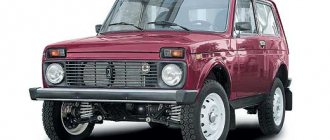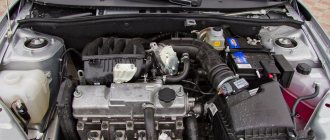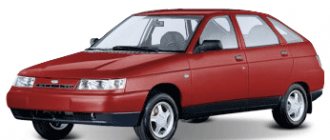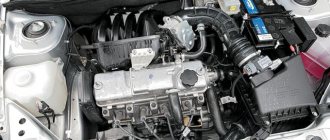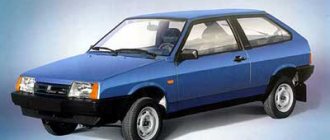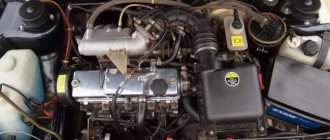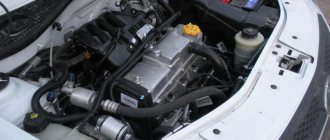What engine
better than VAZ 2103 or VAZ 2106
Auto VAZ-2103 and 2106
, popularly called three and six, have many similarities, because of which many people cannot find the differences between the two models. Indeed, both cars are similar from the outside, and the differences in terms of body features are small. But true car owners can simply cite many signs of the difference between the three and the six, and in this article you, dear readers, will also see the differences.
Place in the VAZ engine line
The entire classic AvtoVAZ line is a redesigned engine of the Fiat 124 model. The alteration was by no means cosmetic; already model 2101 (1970) was noticeably different from the prototype. The camshaft was moved to the upper part of the engine, the piston diameter was increased by 3 mm, and its stroke was reduced by 5.5 mm. At the same time, the engine became more responsive due to its short stroke.
Next came the 21011 engine, the cylinder diameter of which was increased by another 3 mm to a value of 79 mm. Due to this, the engine displacement has increased and the power has increased slightly. In 1972, the VAZ 2103 was released - the first four-eyed model of the Zhiguli. It was equipped with a new and most powerful engine at that time with 71 horsepower. The cylinder diameter was returned to 76 mm, and the piston stroke was increased by 14 mm. The working volume was 1452 cubic cm. This engine for a long time enjoyed the reputation of being the most durable. Even a mileage of 250 thousand km is not an incomprehensible amount for it with proper care and normal operation.
The successor to the 2103 engine (engine 2106) differs from it only in the cylinder diameter increased to 79 mm.
VAZ-2106 "Zhiguli"
As for the appearance of the VAZ-2106, back in 1976, when the first “sixes” rolled off the assembly line, none of its designers imagined that after a certain period of time this model would be the most widespread among all car enthusiasts in the Soviet Union. “Six”, as the VAZ-2106 was popularly called, was developed as a 5-seater passenger car with a sedan body shape, filled with a traditional layout.
Just a couple of years after the release of the first cars, this model became one of the most popular among the series of cars of the Volga Automobile Plant. In fact, the VAZ-2106 is an improved copy of its predecessor, the VAZ-2103.
To sell this car abroad, it was given a more respectable name / Lada 1300SL / Lada 1600 / Lada Junior / Lada 1500L/.
For the interior of the car, the version with the steering wheel on the right was traditionally considered, which was reflected in the appearance of the VAZ-21066.
Unlike similar “brothers”, the VAZ-2106 was produced from the very beginning with a powerful engine, a comfortable interior, which housed more or less comfortable seats with headrests. A tachometer was placed on the instrument panel.
In appearance, the VAZ-2106 was distinguished by the presence of chrome moldings, which were located on the sides of the car. A little later, the steering wheel was upgraded to a four-spoke one, and the radiator grille was repainted black.
Since 2001, this model was discontinued by AVTOVAZ, but its production was moved to IzhMash.
If you do not have your own car, then you will probably need passenger transportation in Penza.
Using a gearbox, torque is transmitted from the engine to the wheels. The gearbox is a set of gears and includes two main blocks: a cross-axle differential and a main gear. When replacing or repairing this module, the question may arise as to how the VAZ 2103 gearbox differs from the 2106, which do not look identical in appearance.
Characteristics of the VAZ 2103 engine
The technical characteristics of the 2103 engine reflect its position in the AvtoVAZ engine line. It was installed on the VAZ 2103, 21023, 21043, 21053, 21061, 2107 models. This is an in-line four-cylinder carburetor internal combustion engine with two valves per cylinder, which runs on AI-92 gasoline. To operate the engine, oil from 5W-30 to 15W-40 is used, with a consumption of 700 g per 1000 km.
Main characteristics of the VAZ 2103 engine
| Name. | Index. |
| Length. | 565 mm. |
| Width. | 541 mm. |
| Height. | 665 mm. |
| Cylinder diameter. | 76 mm. |
| Piston stroke. | 80 mm. |
| Compression ratio. | 8,5. |
| Engine weight. | 121 kg. |
| Compression of the VAZ 2103 engine. | 1 MPa (10 bar). |
| Maximum power at a crankshaft speed of 5600 rpm. | 71 horsepower. |
| Maximum torque at 3400 rpm. | 104 Nm. |
| Fuel consumption when driving on the highway. | 6.9 l per 100 km. |
| Fuel consumption in the urban cycle. | 9.4 l per 100 km. |
| Fuel consumption in the combined cycle. | 8.9 l per 100 km. |
During the life cycle of the VAZ 2103, the engine was repeatedly refined and improved. An injection version of the engine, a version with a contactless ignition system and a host of others were created. These modifications have improved technical characteristics.
The service life of the VAZ 2103 engine, declared by the manufacturer, is 125 thousand km. In practice, the resource is often double the declared one.
What disadvantages will you have to put up with?
All the problems of the VAZ-2106 come from the same period as the car itself. Don't expect miracles from the design of the 70s. The car makes noise, breaks down due to the quality of components, design features and the fact that it is not taken care of, but continues to drive confidently.
The body is characterized by very low corrosion resistance. Even after repainting, “saffron milk caps” will begin to appear on the parts within three years. Door corners, sills and wheel arches are most susceptible to corrosion.
From the point of view of monetary costs, the “six” has no competitors. Everything that fails costs pennies. Whatever your salary, spend little on car maintenance. The assembled engine costs 10 thousand rubles, the assembled gearbox costs 5 thousand rubles.
The disadvantages of the VAZ-2106 include the low level of safety for the driver and passengers. Thin, unreinforced sheet metal in the door arches and in the front of the car will not save even in a low-speed collision. The only passive safety features are seat belts and the aforementioned head restraints.
Also read: Used LADA Granta: execution cannot be pardoned
VAZ 2103 engine design
The VAZ 2103 engine design is a classic engine with an overhead gas distribution mechanism, which has a high cylinder block. The VAZ 2103 carburetor has a distributor with a vacuum ignition timing regulator. The height of the engine is 215.9 mm instead of 207.1 (for the VAZ 2101). This made it possible to increase the working volume to 1.5 liters and use a crankshaft with an increased piston stroke.
The VAZ 2103 cylinder block is cast from special cast iron. The center-to-center distance is 95 mm, which makes it possible to increase the cylinder diameter from 76 to 79 mm. The cylinder head is made of aluminum alloy and its height is 112.5 mm.
To drive the gas distribution mechanism (GRM), a double-row bushing-roller chain with 116 links is used. There is no chain tensioner. To drive the generator and water pump, a V-belt with a cross-section of 10×8 mm and a length of 944 mm is used. The crankshaft has a crank radius of 40 mm and provides a piston stroke of 80 mm.
The pistons and valves of the VAZ 2103 model are similar to the pistons and valves of the 2101 model. The pistons are made of aluminum alloy with the outer surface coated with tin. Piston rings are made of cast iron. The barrel-shaped surface of the upper compression ring is chrome-plated. The lower compression ring is strengthened by phosphating. The oil scraper ring has an expander spring, ground at the ends and along the outer diameter.
Service
Maintenance of the Lada “Classic” engine is often carried out at home. This is due to the simplicity of the design. Maintenance is quite simple for the Lada Classic engine. An oil change is carried out every 10,000 km.
It includes changing the lubricant and oil filter element. The amount of oil required for replacement is 4-4.5 liters. When choosing an oil, everything is simple; the manufacturer recommends using a mineral lubricant.
But, as practice has shown, semi-synthetic motor oil is best suited.
Engine tuning 2103
The potential of the VAZ 2103 engine is so high that it is difficult to resist the temptation to squeeze more out of it. There are craftsmen who squeeze up to 200 horsepower out of a car. This kind of tuning of the VAZ 2103 engine is extreme in nature and is not recommended for everyday driving on regular roads.
There are many options for boosting an engine. One way to increase engine power and improve other performance characteristics is to convert the engine into a VAZ 2106 engine. To do this, you need to bore the cylinders to a diameter of 79 mm and replace the piston group with parts from a six. The remaining elements remain the same, the units are unified in all parts. Assembly of the VAZ 2103 engine after such tuning is carried out without problems.
Another popular way to boost this engine is to install a 0.5 bar compressor on it. This upgrade is quite simple and does not require major modifications. Such tuning can increase power up to 100 horsepower. This is a relatively affordable engine upgrade option. After all, there are ready-made installation kits on the market that provide a pressure of 0.5 or even 0.7 bar.
If you take care of your car and timely repair the VAZ 2103 engine, the car will not let you down on the road. And it will delight its owners for many years with its reliability and excellent driving performance.
The VAZ 2106 (Lada-1600), popularly called the six, is the most popular rear-wheel drive classic sedan model produced by AvtoVAZ. The car was released in 1975 and is a development of the VAZ 2103, where in addition to a modified appearance and a number of technical aspects, the power unit was modified.
In this article, we will look at both the engines themselves that were installed on the six and their characteristics. We will not ignore the shortcomings and weaknesses of these engines.
ENGINE VAZ 2106
Engine VAZ 2106 1.6 l. is a continuation of the three and, as a consequence, the power unit of the penny. The difference between the VAZ 2106 and 2103 is primarily in the piston of increased diameter, while the engine block of the 2106 is the same. There is an option with the index 21067 of the injection type, this is a banal six engine, covered with a cylinder head from the injection Niva engine 21214 from the injection Niva.
In practice, the carburetor engine of the six proved to be better than the injection one. The 2106 engine can be either injection or carburetor type, it is in-line with four cylinders, and has an overhead camshaft. Timing chain drive. The engine is a representative of the “classic” series, which is characterized by a high block.
The main and most common disadvantages of the VAZ 2106 engine include the following. The engine is demanding on oil, as well as on its timely replacement. If this requirement is ignored, the cylinder diameters increase over time. Having mentioned oil, it is necessary to note the fact that the engine is also quite gluttonous when it comes to oil. If this goes beyond reasonable limits, it is necessary to measure the compression, based on the result you can determine what the problem is: valves or rings.
The camshaft wears out quickly on the engine. In addition, it is necessary to adjust the valves in a timely manner, otherwise knocking noises may occur at idle. If we talk about extraneous noises and sounds, it should be noted that: characteristic metallic sounds indicate problems with the piston pins or connecting rod bearings, knocking while the engine warms up indicates problems with the pistons, squeaks indicate problems with the timing chain. In general, the engine is quite noisy and various noises and knocks are a frequent occurrence for it.
Alternative
A few years after the launch of the VAZ 2103 into production, the company introduced its modernized version - 2106.
What are the differences between the VAZ 2103 and the VAZ 2106?
The “Six” is distinguished not only by its later year of manufacture (since 1976).
The new car has differences in:
- A more powerful 1.6-liter engine that develops 80 horsepower.
- Plastic radiator grille, black sections into which head optics are integrated.
- Increased distance between the headlights.
- A different rear optics configuration.
- The presence of an alarm key.
- Rectangular shaped direction indicators on the front fenders.
- Plastic covers on the bumper.
- Two rectangular cutouts at the front to cool the radiator and engine.
Reviews
This “Classic” still delights car enthusiasts. Many consider the Troika to be one of the most durable cars ever produced in the USSR. She captivated us with her high-spirited engine, attractive design and high-quality interior.
However, there are weaknesses in 2103. For example, poor corrosion resistance. This problem has plagued the car since the very beginning of production. The wheel arches, which were deprived of fender liners, were at particular risk. Also, the thresholds are rotting.
There are also complaints about the motor. The latter is prone to overheating, and its cooling system works mediocre.
More detailed information on the problems of a specific model can be found on the Internet, on the corresponding forum. There you can watch useful videos and chat with the owners.
Six engine tuning methods
Forged pistons
The factory usually installs cast pistons. In order to reduce the load, you can use forged ones instead. They have less weight. Moreover, at high speed, casting begins to work less efficiently than forged metal.
You can also replace the connecting rods with H-shaped forged ones, which have a slightly longer length than the original ones. This will improve the compression of the flammable substance. It must be remembered that when increasing the length of the connecting rod, it is necessary to install pistons whose compression height is less than the original one.
As a result, we get a more powerful engine.
Boring process
This method can significantly increase engine power. The classic version has 8 valves. Each of the engine cylinders has 400 cm. For boring, a small layer of steel is removed from the wall of each cylinder. This work is performed on special machines. In principle, you can remove as many layers as the cylinders themselves allow. But you need to remember that this reduces the mileage of the cylinders by thousands of kilometers.
After boring, it becomes possible to install a piston with a larger diameter. As a result, we get an increase in engine power by as much as several tens of horsepower.
Torque.
By installing a more advanced camshaft, engine torque can be significantly increased. For example, you can add up to two thousand revolutions to the engine. As a result, the car will accelerate much better already at first speed than with a standard engine.
Introduction of 16-valve cylinder block
This is a rather complicated procedure that requires deep knowledge of the structure of the six motor. The old block is completely removed, and a new block is placed in its place in a disassembled state. There is no head, gears, belts, etc. installed in it yet. Before completing the assembly, the new sixteen-valve valve must be connected to the gearbox. And only after this the assembly is completed.
Naturally, after this procedure it will not be possible to use the classic Zhiguli gas pump. Some people put a Volga pump in its place.
Also, for a 16V engine you will have to install a more powerful generator. For example, the generator located in the Niva is perfect.
Other parts will also require replacement: camshaft belts and chains, flywheel, crankshaft, release cylinders, ECU, injectors, combustion chambers.
Yes, there is a lot of work. But without all these modifications, you won't be able to experience the full power of the 16-valve engine.
Test
The personification of high status
“Troika” stands out among the entire classic Zhiguli family. Attention is drawn to the chrome bumpers, radiator grille, as well as moldings, which add gloss and laconicism to the body design.
The headlight optics are made separate. This has significantly improved the efficiency of the high beam lighting, and also gives the front end some aggression.
Unobtrusive respectability
The interior captivates with its ergonomic front panel - all controls are located in close proximity to the driver. Finishing materials are of high quality, and assembly is neat.
The front panel consists of a tachometer with a marked zone for maximum engine speed, as well as a speedometer. To the right of them are indicators for fuel level, coolant level, and engine oil pressure. Under the instruments you can find the lights and windshield wipers.
The dashboard is notable for the presence of a clock and a spacious ashtray. The climate system is controlled by two sliders. It heats the interior well in cold weather. As for the standard radio receiver, it has good signal reception and sound.
The front seats have some hint of profile and lateral support, but are still imposing and do not provide the body with proper support. Three people can sit on the back sofa, however, two people will be much more comfortable here due to the folding armrest.
With a twinkle
The half-liter engine gives the Troika a cheerful temperament - it is worth noting good traction at low speeds, as well as playful pick-up at medium speeds. The transmission and clutch work harmoniously, making it easy to get going and shift without jerking.
Moreover, the manual transmission boasts good shift clarity, but the long lever throws are somewhat disappointing.
The steering does a good job of informing the pilot about the angle of rotation of the front wheels and allows active maneuvering at speeds of up to 80 kilometers per hour. Above the specified speed, low sensitivity appears on the steering wheel, and yaw on the road is noticeable.
The suspension ensures a highly smooth ride on any uneven surfaces - even on large potholes there is no vibration or shaking. However, on long asphalt waves the rocking is intrusive.
The braking system deserves a separate discussion. A brake pedal with a long stroke makes it possible to accurately dose the braking force, but if it is depressed sharply, the wheels lock too early, which can lead to loss of control over the car.
Photo VAZ 2103:
What engine
better than VAZ 2103 or VAZ 2106
Auto VAZ-2103 and 2106
, popularly called three and six, have many similarities, because of which many people cannot find the differences between the two models. Indeed, both cars are similar from the outside, and the differences in terms of body features are small. But true car owners can simply cite many signs of the difference between the three and the six, and in this article you, dear readers, will also see the differences.
